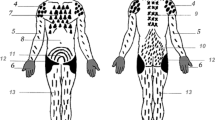Abstract
The paper reports the results of a population-based pain survey in Lübeck, a city of 210,000 inhabitants in the northern part of Germany. Data were collected from 308 respondents (systematic sample aged 26–75 years) by mailed questionnaires (response rate: 80%). Subjects indicated on a list of 11 pain conditions whether they suffered from these kinds of painever, during the past 6 months, or “today”. The prevalence of the 11 pain conditions ranged from 19% to 70% (lifetime prevalence), 14% to 56% (6-month prevalence), and 4% to 29% (point prevalence). Rheumatic pain (e.g., back pain) prevailed; higher prevalence figures were found for females for several pain conditions. Respondents who suffered from pain “today” (n=157) or during the preceding 6 months (n=255) often reported two or more kinds of pain. Ten percent of the respondents reported that they had never experienced any of the 11 pain conditions, 17% did so with respect to the past 6 months, and 49% were free of pain on the day they completed the questionnaire. The classification of pain sufferers according to the number of disability days in the past 6 months showed that three-quarters of them reported 0–6 disability days. However, 8% of the total sample reported more than 14 pain-related disability days and were classified as being affected by pain to a sociomedically relevant degree. Approximately half of the subjects who reported pain in the past 6 months did not consult a physician. This proportion decreased considerably in subgroups with more than 6 disability days.
Zusammenfassung
Es werden Ergebnisse einer postalischen Befragung von 308 deutschen Einwohnern Lübecks im Alter zwischen 26 und 75 Jahren referiert. Für 11 Körperregionen wird die Lebenszeit-, 6-Monats- und Punktprävalenz von Schmerzen beschrieben. Rheumatische Schmerzen dominieren in allen 3 erfaßten Zeiträumen. Mehr als die Hälfte der Personen mit Schmerzen in den vergangenen 6 Monaten bzw. am Befragungstag berichteten über Schmerzen in 2 und mehr Körperregionen. Die Einstufung der von Schmerzen betroffenen Befragten nach dem Grad der Beeinträchtigung von Alltagstätigkeiten zeigt, daß 3/4 dieser Befragten in den zurückliegenden 6 Monaten an höchstens 6 Tagen durch Schmerzen im Alltag eingeschränkt waren. 8% der Befragten weren im gleichen zeitraum an mehr als 14 Tagen bei ihren Alltagstätigkeiten behindert. Der Grad der schmerzbedingten Beeinträchtigung zeigt einen engen Zusammenhang mit der Anzahl der Arztbesuche.
Similar content being viewed by others
Literatur
Brattberg G, Thorslund M, Wikman A (1989) The prevalence of pain in a general population. The results of a postal survey in a county of Sweden. Pain 37:215
Crook J, Rideout E, Browne G (1984) The prevalence of pain complaints in a general population. Pain 18:299
Hunt SM, McKenna SP, McEwen J, Backett EM, Williams J, Papp E (1980) A quantitative approach to perceived health status: a validation study. J Epidemiol Community Health 34:281
Kohlmann T, Raspe HH (1991) Deskriptive Epidemiologie chronischer Schmerzen. In: Geissner E, Jungnitsch G (Hrsg) Psychologie des Schmerzes—Diagnose und Therapie. Psychologie Verlags-Union, Weinheim
Kröner-Herwig B (1990) Chronischer Schmerz—Eine Gegenstandsbestimmung. In: Basler HD, Franz C, Kröner-Herwig B, Rehfisch HP, Seeman H (Hrsg) Psychologische Schmerztherapie. Springer, Berlin Heidelberg New York
Mau W, Wasmus A, Raspe HH (1991) Epidemiologic und Versorgung der rheumatoiden Arthritis (rA) im Stadtgebiet von Hannover. GSF-Forschungszentrum, München
Raspe HH, Wasmus A, Greif G, Kohlmann T, Kindel P, Mahrenholtz M (1990) Rückenschmerzen in Hannover. Akt Rheumatol 15:32
Taylor H, Curran NM (1985) The Nuprin Pain Report. Harris & Associates, New York
Von Korff M, Dworkin SF, Le Resche L, Kruger A (1988) An epidemiologic comparison of pain complaints. Pain 32:173
Von Korff M, Dworkin SF, Le Resche L (1990) Graded chronic pain status: an epidemiologic evaluation. Pain 40:279
Von Korff M, Ormel J, Keefe FJ, Dworkin SF (1991) Graded chronic pain status I: concepts, uses and validity. (forthcoming)
Zimmermann M, Seemann H (1986) Der Schmerz—Ein vernachlässigtes Gebiet der Medizin? Springer, Berlin Heidelberg New York
Author information
Authors and Affiliations
Rights and permissions
About this article
Cite this article
Kohlmann, T. Schmerzen in der Lübecker Bevölkerung. Schmerz 5, 208–213 (1991). https://doi.org/10.1007/BF02527799
Issue Date:
DOI: https://doi.org/10.1007/BF02527799



